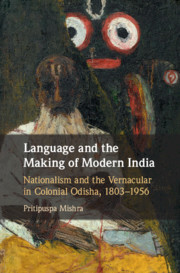 Language and the Making of Modern India
Language and the Making of Modern India Book contents
- Language and the Making of Modern India
- Language and the Making of Modern India
- Copyright page
- Dedication
- Contents
- Maps
- Acknowledgments
- Additional material
- Introduction
- 1 How the Vernacular Became Regional
- 2 Vernacular Publics: A Modern Odia Readership Imagined
- 3 The Odia Political Subject and the Rise of the Odia Movement
- 4 Odisha as Vernacular Homeland
- 5 The Invisible Minority: History and the Problem of the Adivasi
- 6 The Genius of India: Linguistic Difference, Regionalism, and the Indian Nation
- Postscript
- Bibliography
- Index
- References
Bibliography
Published online by Cambridge University Press: 02 January 2020
- Language and the Making of Modern India
- Language and the Making of Modern India
- Copyright page
- Dedication
- Contents
- Maps
- Acknowledgments
- Additional material
- Introduction
- 1 How the Vernacular Became Regional
- 2 Vernacular Publics: A Modern Odia Readership Imagined
- 3 The Odia Political Subject and the Rise of the Odia Movement
- 4 Odisha as Vernacular Homeland
- 5 The Invisible Minority: History and the Problem of the Adivasi
- 6 The Genius of India: Linguistic Difference, Regionalism, and the Indian Nation
- Postscript
- Bibliography
- Index
- References
- Type
- Chapter
- Information
- Language and the Making of Modern IndiaNationalism and the Vernacular in Colonial Odisha, 1803–1956, pp. 233 - 243Publisher: Cambridge University PressPrint publication year: 2020
- Creative Commons
- This content is Open Access and distributed under the terms of the Creative Commons Attribution licence CC-BY-NC 4.0 https://creativecommons.org/cclicenses/


